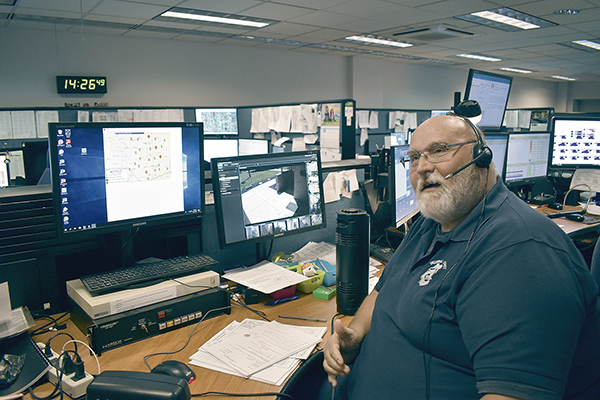On tornado alert
Warning sirens keep residents informed of danger

Staff photo / Renee Fox Dale Hahne, a supervisor at the Trumbull County 911 Center and SkyWarn skywatcher, demonstrates how to use the tornado warning system to alert people to possible devastation. Hahne, also a storm chaser, tests the system people rely on.
You might often hear weather warning sirens sounding though there’s not a cloud in the sky.
That’s because the systems in the Mahoning Valley are tested regularly so that when skies go black, the sirens work to alert residents of real danger.
And in places like Trumbull County, where all county sirens are activated no matter where a funnel cloud or tornado is spotted, residents of Cortland might hear a siren under blue skies, while residents of Newton Falls are under threat.
It’s better to be safe than sorry, officials at the controls say.
WICKED STORMS
Trumbull County has a wicked storm past, from a January F-1 tornado that ripped through a Bazetta cemetery in 2019, to the infamous May 31, 1985, tornado through Niles and Newton Falls, and other communities, that killed several people and destroyed property.
That storm was part of one of the deadliest storm systems in the United States, generating 43 tornadoes and dangerous thunderstorms in Ohio, Pennsylvania, New York and Ontario, Canada, and killing 89 people, according to the National Weather Service.
“In fact, since May 31, 1985, only two tornado days have been deadlier in the entire United States,” a NWS fact page about the storm states. “The storms were the result of high levels of atmospheric instability present in an environment favorable for tornadic thunderstorms, triggered by the passage of a strong late-spring cold front.”
The National Oceanic and Atmospheric Administration said the storm “outbreak” showed that “under the proper atmospheric conditions, major tornadoes can occur irrespective of the location or terrain.”
During a June 2019 twister, Lisa Meixelberger of Warren told the Tribune Chronicle she was in her backyard when she noticed the color of the sky changing and winds picking up. She saw a wide, light gray, swirling funnel cloud headed toward her. She ran for the house.
“There were toys and other things flying in the sky,” Meixelberger said. “It sounded like a freight train running over us.”
Miranda Wargo of Warren told the newspaper: “It was like a sandstorm.”
Following the storm that damaged numerous houses in Warren, residents and off-duty police officers and firefighters knocked on doors to make sure their neighbors were OK, and working together to clean up debris, Robin Martorana of Warren told the newspaper.
“There was a real sense of community spirit,” she said.
DISPATCHING WARNING
Much like tornado cleanups, tornado warning is a community effort, too.
In Trumbull County, 911 dispatchers reading radar, officers and firefighters who act as witnesses on the ground, news meteorologists and weather officials at the NWS work together to identify funnel clouds in troublesome systems and determine when to sound an alert.
“There are times when the NWS can’t tell what is going on below the cloud cover or rain, but the officers on the ground can,” said Dale Hahne, a supervisor at the 911 center. “It happens really quickly.”
Dispatchers in the center track the radar and communicate with NWS officials, Hahne said. Sometimes the center has enough information to issue an alert before the NWS does, he said. And sometimes, the twisters come in and out of existence so fast there isn’t time to sound the alarms, he said.
During an emergency, the county’s sirens sound for three minutes, and then pause for seven in a cycle that lasts as long as the warning is in play.
During the time, dispatchers keep an eye on the path of the storm and take phone calls from people reporting damage or who saw a funnel cloud form or touch down. If the NWS issues an alert, they contact the county to ensure it was received, Hahne said. The dispatchers assess damage, identify resources that are needed and send first responders to handle storm damage, he said.
MANY SIRENS
Trumbull County has 90 sirens, but breaks them into three categories. There are 23 “tier one” sirens received through emergency management grants. The 911 center activates all of the sirens with one tone and monitors the systems to ensure they work, testing them at noon on the first Saturday of the month. The communities are responsible for maintaining the sirens.
There are also 33 “tier two” sirens that are owned and maintained by local communities that are not compatible with the 911 activation module and are activated with multiple tones on multiple towers, taking one minute and 20 seconds to activate them all. The 911 center does not receive information if the siren fails.
And, there are 34 sirens that are activated by the communities where they are placed. The 911 center receives no information about the siren’s function.
Efforts are underway to update those second and third tier sirens, said Steve Craiger, assistant fire chief at the Bristol Fire Department.
Craiger, who serves on the executive committee for the Trumbull County Emergency Management Agency, said a few years ago the committee realized there was a problem with the county’s warning system.
“We have tornado sirens in the county, but the way they are activated takes a lengthy time period between when the first signal goes out to when the last one goes out because there are so many independent systems out there,” Craiger said.
Working with Rodger Laird, the operations manager for the 911 center, and in the past the former director of the center, Ernie Cook, the committee gathered together information about the makes and models of the different sirens.
“We decided to work toward a goal for a single system with single, immediate activation for the whole county,” Craiger said.
By the fall, Craiger said the committee hopes to know what equipment the county needs and how much it will cost. From there, the plan is to apply for grants.
“The system now does work, but it is getting older than we like and it does need to be replaced and repaired more,” he said.
And, an updated system will work with the county’s updated, digital Multi-Agency Radio Communication System (MARCS), Craiger said.
According to the 911 center, the sirens aren’t meant to alert people indoors, so people should sign up for weather alerts through the NOAA weather app, the wireless emergency alert system and the Emergency Alert System.
MAHONING COUNTY
Mahoning County has not had the type of tornado that devastated Trumbull County in 1985, but tornadoes do happen here, like the one that hit the Ellsworth-Canfield area July 8, 2014, damaging 10 homes on its eastward march.
Rich Tribus of Williamsburg Road in Canfield said he received weather alerts on his phone about 15 minutes before that storm knocked down 25 to 30 trees on his property. “The last one I got was 15 minutes before — and said thunderstorm warning,” he told The Vindicator.
Dennis O’Hara, director of the Mahoning County Emergency Management Agency, said the 52 tornado sirens in Mahoning County, which his agency maintains, are an important tool in alerting residents to approaching emergencies. But emergency alerts by text, phone or email also are important.
On the Mahoning County Emergency Management website, a person can sign up for a free system for their phone or email that alerts them to emergencies such as tornado warnings.
It is the same system Youngstown State University uses, but Mahoning County’s alert system is called Ready Mahoning alerts.
“Every tool to notify the public is valuable,” O’Hara said.
Ready Mahoning alerts do not eliminate the need for sirens, but they may be better at alerting someone indoors than a siren.
“The siren is still a tool to notify the public of an emergency. That’s why we don’t want to eliminate them,” he said.
Another tool is a weather-alert radio, which sends information directly from the National Weather Service. These are available for purchase from many retailers.
The 2014 Ellsworth-Canfield tornado was an EF1, the next-to smallest type of tornado. It hit around 2:15 p.m. and had estimated winds of 90 miles per hour and a maximum path width of 800 yards. It traveled about five miles, according to the National Weather Service in Cleveland.
O’Hara said there have been a couple of small tornadoes in Mahoning County since he started working for the agency 14 years ago, including the 2014 twister.
“Thankfully we have not had any injuries from them, but we have had a couple of them,” he said. “Thankfully, we have not had the severity of the 1985 tornado. Nobody is immune to them. We can have them 12 months a year anywhere in Ohio.”
TESTING AND MAINTENANCE
Mahoning County’s emergency sirens are tested nearly every Saturday at noon for one minute. The tests help EMA identify sirens not working properly.
“They may have some speakers that have gone out or the batteries have died. All of our sirens are operated on batteries. They are charged on a trickle charge. This way, in the event of a power outage, they can still operate. They are controlled by radio,” he said.
Mahoning County has purchased its sirens in “batches” over the years, starting with old civil defense sirens from the Cold War era starting in the 1950s.
The newer ones were purchased starting in the 1990s. The newest ones are from 2014. The cost to install the newest siren was a little more than $25,000 in 2014 when one was installed on the Mahoning County jail.
The one on top of Youngstown City Hall was installed as a civil defense siren.
Mahoning County has a countywide system. It means that if the National Weather Service in Cleveland issues a tornado warning, the warning automatically sets off the 52 sirens in Mahoning County, O’Hara said. The same is true for Saturday test sirens.
Sirens also can be set off manually “in the event that there is an issue with our equipment,” O’Hara said.



